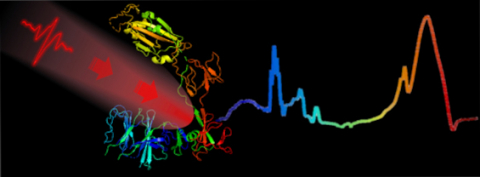Secondary Structures of MERS-CoV, SARS-CoV, and SARS-CoV-2 Spike Proteins Revealed by Infrared Vibrational Spectroscopy

COVID-19 pandemic condition has posed serious challenges for both society and scientific community. One of the major goals is to guarantee occupational health and environmental security, adopting new tools and techniques to monitor the air-quality, such as optical biosensors, based on infrared (IR) spectroscopy. The first step towards the development of an IR sensoristic platform is the knowledge of spectral features of specific molecules, including spike glycoproteins of pathogens and their complex secondary structures. A comparative IR study of viral S1 proteins from MERS-CoV, SARS-CoV, SARS-CoV-2 is presented in the paper Secondary Structures of MERS-CoV, SARS-CoV, and SARS-CoV-2 Spike Proteins Revealed by Infrared Vibrational Spectroscopy, recently published on International Journal of Molecular Sciences by A. D’Arco, T. Mancini and S. Lupi. Measuring, for the first time, the Amide I IR absorption bands of MERS-CoV, SARS-CoV, SARS-CoV-2, the secondary structures of these proteins have been investigated. Notably, SARS-CoV-2 S1 secondary structure shows a strong difference compared to those of MERS-CoV and SARS-CoV, with a significant presence of extended β-sheets. This secondary structure promotes a major stability to the protein.
Furthermore, the conformation of the SARS-CoV-2 S1 showed a significant change by moving from serological pH to mild acidic and alkaline pH conditions.
These data indicate the ability of SARS-CoV-2 S1 glycoprotein to adapt to a variable environment, pointing out the strong role of the S1 protein secondary structure in the virus transmissibility and infectious process. This work was funded by the NATO Science for Peace and Security Program under grant No. 5889 “SARS-CoV-2 Multi-Messenger Monitoring for Occupational Health & Safety (SARS 3M)”, and FISR2020 “Monitoraggio multi-messaggero e di apprendimento automatico di SARS-CoV-2 per la salute e la sicurezza sul lavoro (4M SARS-CoV-2)”
Authors:
Annalisa D'Arco, Marta Di Fabrizio, Tiziana Mancini, Rosanna Mosetti, Salvatore Macis, Giovanna Tranfo, Giancarlo Della Ventura, Augusto Marcelli, Massimo Petrarca, Stefano Lupi
Article:
International Journal of Molecular Sciences
https://doi.org/10.3390/ijms24119550
